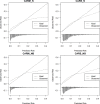Accuracy of automated computer-aided risk scoring systems to estimate the risk of COVID-19: a retrospective cohort study
- PMID: 38637897
- PMCID: PMC11027522
- DOI: 10.1186/s13104-024-06773-0
Accuracy of automated computer-aided risk scoring systems to estimate the risk of COVID-19: a retrospective cohort study
Abstract
Background: In the UK National Health Service (NHS), the patient's vital signs are monitored and summarised into a National Early Warning Score (NEWS) score. A set of computer-aided risk scoring systems (CARSS) was developed and validated for predicting in-hospital mortality and sepsis in unplanned admission to hospital using NEWS and routine blood tests results. We sought to assess the accuracy of these models to predict the risk of COVID-19 in unplanned admissions during the first phase of the pandemic.
Methods: Adult ( > = 18 years) non-elective admissions discharged (alive/deceased) between 11-March-2020 to 13-June-2020 from two acute hospitals with an index NEWS electronically recorded within ± 24 h of admission. We identified COVID-19 admission based on ICD-10 code 'U071' which was determined by COVID-19 swab test results (hospital or community). We assessed the performance of CARSS (CARS_N, CARS_NB, CARM_N, CARM_NB) for predicting the risk of COVID-19 in terms of discrimination (c-statistic) and calibration (graphically).
Results: The risk of in-hospital mortality following emergency medical admission was 8.4% (500/6444) and 9.6% (620/6444) had a diagnosis of COVID-19. For predicting COVID-19 admissions, the CARS_N model had the highest discrimination 0.73 (0.71 to 0.75) and calibration slope 0.81 (0.72 to 0.89) compared to other CARSS models: CARM_N (discrimination:0.68 (0.66 to 0.70) and calibration slope 0.47 (0.41 to 0.54)), CARM_NB (discrimination:0.68 (0.65 to 0.70) and calibration slope 0.37 (0.31 to 0.43)), and CARS_NB (discrimination:0.68 (0.66 to 0.70) and calibration slope 0.56 (0.47 to 0.64)).
Conclusions: The CARS_N model is reasonably accurate for predicting the risk of COVID-19. It may be clinically useful as an early warning system at the time of admission especially to triage large numbers of unplanned admissions because it requires no additional data collection and is readily automated.
Keywords: COVID-19; Computer-aided risk scoring systems; Mortality risk; National early warning score.
© 2024. The Author(s).
Conflict of interest statement
The authors declare no competing interests.
Figures


Similar articles
-
Development and validation of a novel computer-aided score to predict the risk of in-hospital mortality for acutely ill medical admissions in two acute hospitals using their first electronically recorded blood test results and vital signs: a cross-sectional study.BMJ Open. 2018 Dec 6;8(12):e022939. doi: 10.1136/bmjopen-2018-022939. BMJ Open. 2018. PMID: 30530474 Free PMC article.
-
Predictive accuracy of enhanced versions of the on-admission National Early Warning Score in estimating the risk of COVID-19 for unplanned admission to hospital: a retrospective development and validation study.BMC Health Serv Res. 2021 Sep 13;21(1):957. doi: 10.1186/s12913-021-06951-x. BMC Health Serv Res. 2021. PMID: 34511131 Free PMC article.
-
Development and validation of automated computer-aided risk scores to predict in-hospital mortality for emergency medical admissions with COVID-19: a retrospective cohort development and validation study.BMJ Open. 2022 Aug 30;12(8):e050274. doi: 10.1136/bmjopen-2021-050274. BMJ Open. 2022. PMID: 36041761 Free PMC article.
-
External validation of the computer aided risk scoring system in predicting in-hospital mortality following emergency medical admissions.Int J Med Inform. 2024 Aug;188:105497. doi: 10.1016/j.ijmedinf.2024.105497. Epub 2024 May 18. Int J Med Inform. 2024. PMID: 38781886
-
Prevention of unplanned intensive care unit admissions and hospital mortality by early warning systems.Dimens Crit Care Nurs. 2013 Nov-Dec;32(6):300-9. doi: 10.1097/DCC.0000000000000004. Dimens Crit Care Nurs. 2013. PMID: 24100432 Review.
References
MeSH terms
Grants and funding
LinkOut - more resources
Full Text Sources
Medical

